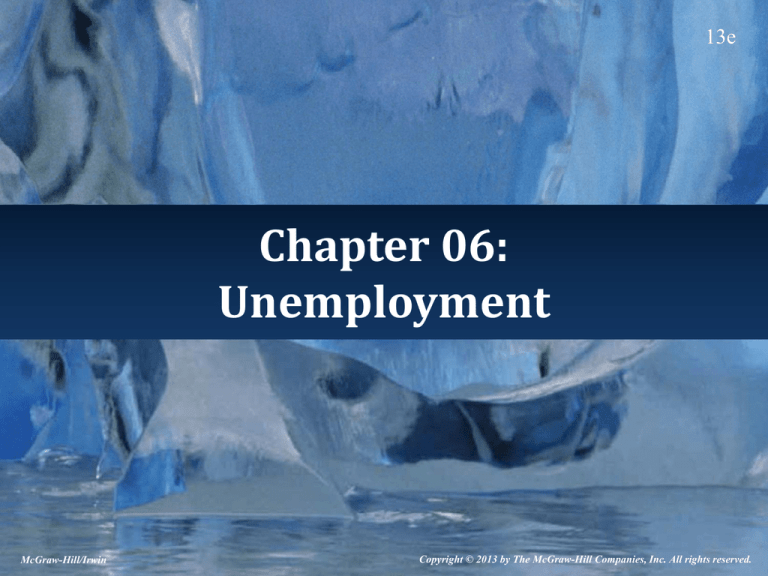
13e
Chapter 06:
Unemployment
McGraw-Hill/Irwin
Copyright © 2013 by The McGraw-Hill Companies, Inc. All rights reserved.
Learning Objectives
• 06-01. Know how unemployment is
measured.
• 06-02. Know the socioeconomic costs of
unemployment.
• 06-03. Know the major types of
unemployment.
• 06-04. Know the meaning of “full
employment.”
6-2
The Labor Force
• Labor force: all persons age 16 and over who
are either employed or actively seeking work.
– Out of the labor force: those not working and
not actively seeking employment.
Total
population
Out of the
labor force
Employed
Labor force
Unemployed
6-3
Impact of Labor Force Growth
• The labor force grows
due to population growth
and immigration, adding
2 million new workers
yearly.
• The PPC pushes outward,
increasing the capacity to
produce goods and
services.
– We need to create 2
million new jobs for the
expanding labor force, or
we end up at point F
inside the PPC.
6-4
Unemployment
• Unemployment: the inability of labor force
participants to find jobs.
• This is an idled resource, so the economy
operates inside its PPC, in the inefficient
zone.
– Okun’s Law: a 1 percent increase in
unemployment results in a 2 percent decrease
in GDP.
6-5
Measuring Unemployment
• A person is counted as unemployed if he or
she is not working but is actively seeking
work.
• Unemployment rate: the proportion of the
labor force that is unemployed:
Unemployment rate =
Number of unemployed people
Labor force
14,825,000
2010 unemployment rate =
= 9.6%
153,889,000
6-6
Demographics of Unemployment
• The unemployment rate is higher for
– Men than women.
– Blacks and Hispanics than whites.
– Less educated people than higher-educated
people.
– Teenagers than people older than them.
6-7
Duration of Unemployment
• Duration: how long does joblessness last?
• When the economy is growing, both the
unemployment rate and the duration
decrease.
• When the economy stagnates or goes into
decline, both the unemployment rate and
the duration increase.
6-8
Reasons for Unemployment
• Job leavers.
– They quit to seek other
opportunities.
• Job losers.
– They are laid off or fired.
• New entrants.
– First-time job seekers.
• Reentrants.
– They had left the labor
force but have returned.
6-9
Discouraged Workers
• Former job seekers who have given up and
no longer actively seek employment.
– They drop out of the labor force.
– They are no longer counted in unemployment
statistics.
6-10
Underemployment
• People who want full-time work in their
field but can find only part-time work or
work at jobs below their capability.
– They are counted as employed.
6-11
Defining Full Employment
• Full employment is not the same as zero
unemployment.
• There are four categories of unemployment.
– Seasonal unemployment.
– Fictional unemployment.
– Structural unemployment.
– Cyclical unemployment.
• At full employment, all of these exist except
cyclical unemployment.
6-12
Defining Full Employment
• Seasonal unemployment: unemployment
due to seasonal changes in employment.
• The Labor Department reports seasonally
adjusted unemployment rates for every
month.
– Unemployment data exclude the effects of
seasonal unemployment.
6-13
Defining Full Employment
• Frictional unemployment: brief periods of
unemployment experienced by people
moving between jobs or into the labor
market.
– Adequate demand for frictionally unemployed.
– They have skills required for existing jobs.
– The job search period is relatively short.
6-14
Defining Full Employment
• Structural unemployment: unemployment
caused by a mismatch between the skills (or
location) of job seekers and the
requirements (or location) of available jobs.
– Caused by a change in the market for the
product made, or
– … a change in the technology or process by
which the goods is made.
6-15
Defining Full Employment
• Cyclical unemployment: unemployment
caused by a decline in economic activity.
– The demand for products decreases and
workers get laid off.
– Results in an excess supply of workers for the
remaining available jobs.
– The economy must grow at least as fast as the
labor force to avoid cyclical unemployment.
6-16
Defining Full Employment
• Economists think that we are near full
employment when rising prices signal that
we are nearing production capacity – that is,
the PPC.
• Inflationary flashpoint: the rate of output
at which inflationary pressures intensify.
• Full employment: the lowest
unemployment rate compatible with price
stability; zero cyclical unemployment.
6-17
Defining Full Employment
• Full employment: the lowest
unemployment rate compatible with price
stability; zero cyclical unemployment.
– Both frictional and structural unemployment
exist at full employment.
• Full employment ranges between 4 and 6
percent unemployment, depending on the
size of structural unemployment.
6-18
Changes in Structural
Unemployment
• Changes in structural unemployment come from
changes in society itself.
–
–
–
–
Growing numbers of youth and women.
Changes in transfer payments for the jobless.
Changes in products demanded by consumers.
Changes in how (and where) products are made.
• During periods of change, structural
unemployment increases.
• When changes are fully absorbed, structural
unemployment decreases.
6-19
The “Natural” Rate of Unemployment
• Natural rate of unemployment: long-term
rate of unemployment determined by
structural forces in labor and product
markets.
6-20








